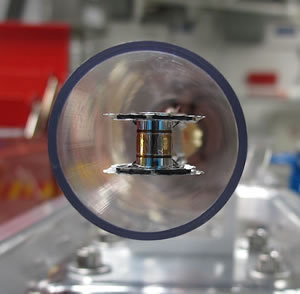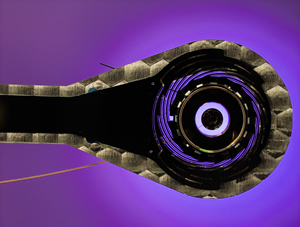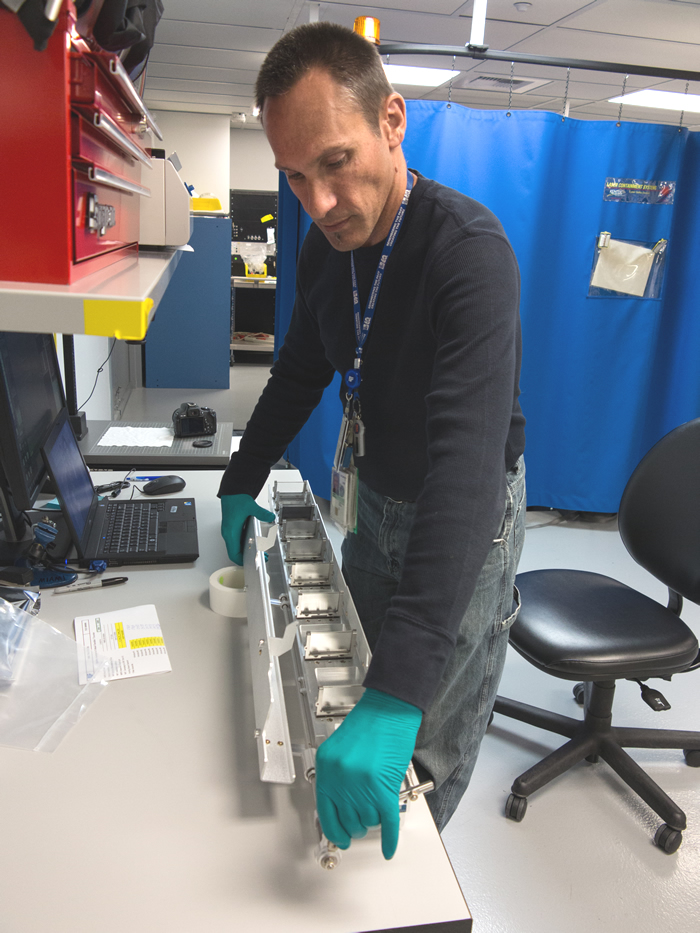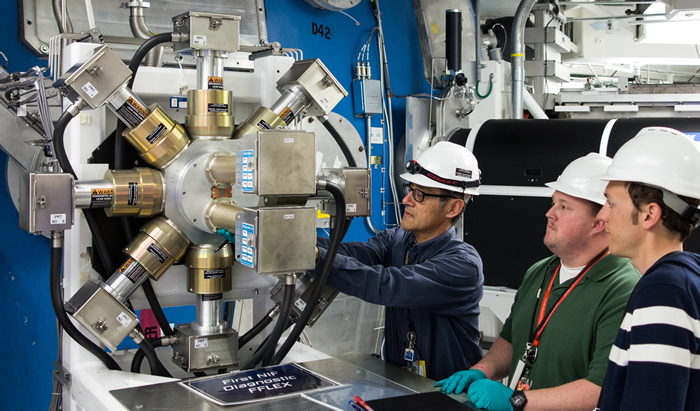NIF Status Update – 2014
March
NIF Shot Rate Ramps Up
Reflecting NIF’s emphasis on increasing shot availability, the NIF Team conducted 49 target shots in 39 shot days during the second quarter of Fiscal Year 2014, for an average of 1.25 shots per shot day. This was an improvement over the first quarter, when 23 shots were fired in 27 shot days, or 0.9 shots per shot day. Here are some highlights of experiments conducted in March:
 The depleted uranium hohlraum installed in the cryogenic target positioner for the March 4-5 high-foot layered DT implosion experiment.
The depleted uranium hohlraum installed in the cryogenic target positioner for the March 4-5 high-foot layered DT implosion experiment. - A two-dimension convergent ablator experiment was conducted on March 3 to study the effect of hohlraum fill density on hohlraum and capsule performance. The two-shock high-foot (high initial laser pulse) experiment used a high-density carbon (diamond) near-vacuum target capsule in a 6.72-millimeter-diameter hohlraum. The goals were to determine the extent to which hohlraum fill-gas can improve control of compression symmetry; measure the onset of backscatter; and determine drive degradation as a function of gas-fill density. The hohlraum fill density was 0.6 mg/cm3 of helium compared with a previous, “near vacuum” hohlraum experiment (0.03 mg/cm3). Good target diagnostic data were acquired; preliminary analysis indicates that laser coupling was close to the levels measured for near-vacuum hohlraums.
- On March 4-5, the NIF Team conducted a high-foot layered cryogenic deuterium-tritium (DT) experiment using a depleted uranium (DU) hohlraum. The shot used slightly higher power than the previous DU experiment in January; preliminary results indicate that performance was similar to the January shot, with neutron yield estimated at 9.8 × 1015 (9.8 quadrillion).
- On March 6, the team conducted a polar direct-drive (PDD) experiment to test PDD performance at higher laser intensity. The direct-drive campaign is led by the Laboratory for Laser Energetics (LLE) at the University of Rochester.
 A high-density carbon (diamond) capsule is suspended by 45-nanometer-thin tents in the convergent ablator target hohlraum used in the March 10 NIF experiment. The stalk at 10:00 holds the iron backlighter target that illuminates the imploding capsule to take in-flight images. (Credit: Robert Acree). The experiment used a 2.2-millimeter diameter, 100-micron-thick plastic capsule filled with 20 atmospheres of deuterium. The shot produced good data showing higher fast-electron production than in lower-intensity shots, as expected.
A high-density carbon (diamond) capsule is suspended by 45-nanometer-thin tents in the convergent ablator target hohlraum used in the March 10 NIF experiment. The stalk at 10:00 holds the iron backlighter target that illuminates the imploding capsule to take in-flight images. (Credit: Robert Acree). The experiment used a 2.2-millimeter diameter, 100-micron-thick plastic capsule filled with 20 atmospheres of deuterium. The shot produced good data showing higher fast-electron production than in lower-intensity shots, as expected. - The fourth experiment in the Los Alamos National Laboratory high energy density shear/shock campaign was conducted on March 7. The experiment used two half hohlraums to produce shock waves from opposite ends of a foam-filled shock tube. The counter-propagating shocks were observed by x-ray backlighting. An x-ray streak camera continuously measured the interface width between the two propagating shocks. Pinching and expansion of the interface was observed.
- The second two-shock diamond capsule convergent ablator experiment in the campaign to study the effect of hohlraum fill gas density on hohlraum and capsule performance was conducted on March 10. The shot was similar to the March 3 experiment but with a longer pulse to ensure control of laser backscattering. Preliminary measurements of backscatter indicate that it remained low.
- On March 11-12, the third high-foot layered DT implosion experiment using a thin-shell plastic capsule was conducted. This was a tuning experiment intended to improve the shape of the fuel hot spot using a nominal-length gold hohlraum. The reduced capsule thickness was 176 microns, while the drive peak power was increased from 350 terawatts (TW) in the previous experiment to 380 TW. Preliminary analysis indicates the neutron yield was about 5 × 1015, an increase of about 70 percent over the previous shot.
- On March 14, the NIF Team fired the first room-temperature “keyhole” shock-timing experiment in an ignition scale 575 (5.75-millimeter-diameter) hohlraum. The experiment’s primary purpose was to demonstrate that shock-timing data can be measured using the Velocity Interferometer System for Any Reflector (VISAR) diagnostic in a room-temperature hohlraum. The VISAR and SOP (streaked optical pyrometer) diagnostics recorded excellent quality data; the results will be used to design future room-temperature shape-tuning experiments.
- Also on March 14, the team conducted a target diffraction in-situ (TARDIS) shot to measure diffraction from solid tantalum at five megabars (Mbar) of pressure. In TARDIS experiments, a sample is ramp-probed with diffracted x-rays emanating from a backlighter source foil. Diffracted x-rays from the shocked crystal are recorded onto image plates. At least four lines from the compressed tantalum were observed.
- Two ablative Rayleigh-Taylor instability growth shots for the Fundamental Science Campaign were conducted on March 17 and 18. The experiments measured instability growth at 50- and 150-micron spatial wavelengths. Modulation growth in a foil driven by the lower halfraums (half hohlraums) was measured by backlighters through tilted slits. The drive foil position was measured with a vanadium sidelighter and a fiducial (reference point) grid. The experiment successfully met all physics goals and the results will be compared to post-shot simulations.
- On March 20-21, the team conducted a TARDIS experiment to measure the diffraction of solid lead compressed to one Mbar. A backlighter was used to provide the x-ray beam to measure diffraction through the shocked sample.
- The second warm shock-timing platform commissioning experiment was conducted on March 22. As in the March 14 initial experiment, the pulse shape included higher and lower peak power pulses on the outer quads to obtain a stimulated Raman scattering measurement without cross-beam energy transfer. This was the first shot to use a water-filled capsule to emulate a cold target liquid deuterium-filled capsule; good data were obtained.
 Diagnostic technician Wayne Abreu closes the cover on a new MRS (magnetic recoil spectrometer) “ironing board” containing nine detector plates with aluminum or Mylar filters. They detect magnetically deflected protons produced by collisions with fusion neutrons. The instrument is used to characterize the energy spectrum of emitted fusion neutrons and provides an accurate estimate of the fraction of neutrons slowed down by the dense DT fuel assembled around the hot spot. The new detector system was deployed in the March 11-12 DT implosion experiment.
Diagnostic technician Wayne Abreu closes the cover on a new MRS (magnetic recoil spectrometer) “ironing board” containing nine detector plates with aluminum or Mylar filters. They detect magnetically deflected protons produced by collisions with fusion neutrons. The instrument is used to characterize the energy spectrum of emitted fusion neutrons and provides an accurate estimate of the fraction of neutrons slowed down by the dense DT fuel assembled around the hot spot. The new detector system was deployed in the March 11-12 DT implosion experiment.  Benjamin Bachmann, a postdoc from Germany (right), Eric Huffman of the Livermore National Security Technologies ( NSTec) office, and Senior Engineer Bob Chow (left) discuss how to fit an upgraded EHXI (equatorial hard x-ray imager) pinhole assembly between two FFLEX filter fluorescer) photomultiplier tubes. When used in hohlraum experiments, the EHXI provides positions of the beams in the hohlraum from the x-rays transmitted through the hohlraum walls.
Benjamin Bachmann, a postdoc from Germany (right), Eric Huffman of the Livermore National Security Technologies ( NSTec) office, and Senior Engineer Bob Chow (left) discuss how to fit an upgraded EHXI (equatorial hard x-ray imager) pinhole assembly between two FFLEX filter fluorescer) photomultiplier tubes. When used in hohlraum experiments, the EHXI provides positions of the beams in the hohlraum from the x-rays transmitted through the hohlraum walls. Spring NIF Maintenance Period Begins
The spring 2014 Facility Maintenance and Reconfiguration Period (FM&R) began on March 22 and is scheduled to extend through April 28. Major activities include:
- A comprehensive IT maintenance, servicing and upgrade
- Near-backscatter imager scatter plate upgrade, diagnostic instrument manipulator maintenance, and Target Chamber first wall modifications
- Preamplifier beam transport system settings for the Advanced Radiographic Capability
- Roving mirror diagnostic assembly maintenance, repair, and calorimeter replacement
- Target positioner cable track upgrade
- Replacement and reconditioning of about 40 final optics frequency-tripler crystals, which convert the infrared light from the NIF beamlines to ultraviolet.




